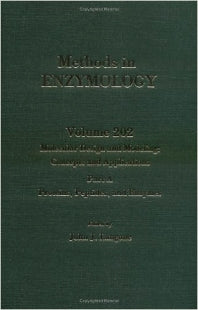Freshly Printed - allow 10 days lead
Couldn't load pickup availability
Molecular Design and Modeling: Concepts and Applications, Part A: Proteins, Peptides, and Enzymes
John N. Abelson (Editor-in-chief), Melvin I. Simon (Editor-in-chief), John J. Langone (Volume editor)
9780121821036, Elsevier Science
Hardback, published 2 December 1991
824 pages
22.9 x 15.1 x 4.1 cm, 1.27 kg
Praise for the Series"The Methods in Enzymology series represents the gold-standard." --NEUROSCIENCE"Incomparably useful." --ANALYTICAL BIOCHEMISTRY"It is a true 'methods' series, including almost every detail from basic theory to sources of equipment and reagents, with timely documentation provided on each page." --BIO/TECHNOLOGY"The series has been following the growing, changing and creation of new areas of science. It should be on the shelves of all libraries in the world as a whole collection." --CHEMISTRY IN INDUSTRY"The appearance of another volume in that excellent series, Methods in Enzymology, is always a cause for appreciation for those who wish to successfully carry out a particular technique or prepare an enzyme or metabolic intermediate without the tiresome prospect of searching through unfamiliar literature and perhaps selecting an unproven method which is not easily reproduced." --AMERICAN SOCIETY OF MICROBIOLOGY NEWS"If we had some way to find the work most often consulted in the laboratory, it could well be the multi-volume series Methods in Enzymology...a great work." --ENZYMOLOGIA"A series that has established itself as a definitive reference for biochemists." --JOURNAL OF CHROMATOGRAPHY
Computer-based design and modeling, computational approaches, and instrumental methods for elucidating molecular mechanisms of protein folding and ligand-acceptor interactions are included in Volumes 202 and 203, as are genetic and chemical methods for the production of functional molecules including antibodies and antigens, enzymes, receptors, nucleic acids and polysaccharides, and drugs.
Proteins and Peptides: Principles and Methods: Protein Folding, Stability, and Function:N.M. Allewell and H. Oberoi, Electrostatic Effects in Protein Folding, Stability, and Function.C. Lawrence and S. Bryant, Hydrophobic Potentials from Statistical Analysis of Protein Structures.K. Nishikawa and T. Noguchi, Predicting Protein Secondary Structure Based on Amino Acid Sequence.T. Niermann and K. Kirschner, Use of Homologous Sequences to Improve Protein Secondary Structure Prediction.B.L. Sibanda and J.M. Thornton, Conformation of ~gb-Hairpins in Protein Structures: Classification and Diversity in Homologous Structures.A. Matouschek and A.R. Fersht, Protein Engineering in the Analysis of Protein Folding Pathways and Stability.P.A. ~Jennings, S.M. Saalau-Bethell, B.E. Finn, X. Chen, and C.R. Matthews, Mutational Analysis of Protein Folding Mechanisms.Design and Modeling:R.A. Lewis, Clefts and Binding Sites in Protein Receptors.N. Summers and M. Karplus, Modeling of Side Chains, Loops, and Insertions.L.H. Holley and M. Karplus, Neural Networks.V.E. Reyes, R.A. Lew, S. Lu, and R.E. Humphreys, Prediction of ~ga Helices and T-Cell-Presented Sequences in Proteins with Algorithms Based on Strip-of-Helix Hydrophobicity Index.J. Greer, Comparative Modeling of Homologous Proteins.B.I. Cohen, S.R. Presnell, and F.E. Cohen, Pattern-Based Approaches to Protein Structure Prediction.J. de Vlieg and W.F. van Gunsteren, Combined Procedures of Distance Geometry and Molecular Dynamics ~for Determining Protein Structure from NMR Data.J. Ellman, S. Anthony-Cahill, C.J. Noren, and P.G. Schultz, Biosynthetic Method for Introducing Unnatural Amino Acids Site Specifically into Proteins.M. Matsumura and B.W. Matthews, Stabilization of Functional Proteins by Introduction of Multiple Disulfide Bonds.C.A. Hutchison III, R. Swanstrom, and D. Loeb, Complete Mutagenesis of Protein Coding Domains.J.A. Wells, Systemic Mutational Analysis of Protein-Protein Interfaces.P.E. Smith, F. Al-Obeidi, and B.M. Pettitt, Design of Conformationally Constrained Peptides.W.M. Bryan, Design of Minimum Active Fragments of Biologically Active Peptides.A.D. MacKerell, Jr. , Molecular Modeling and Dynamics of Biologically Active Peptides: Application~to Neuropeptide Y. Enzymes:M.E. Davis, J.D. Madura, J. Sines, B.A. Luty, S.A. Allison and J.A. McCammon, Diffusion-Controlled Enzymatic Reactions.T.P. Straatsma and J.A. McCammon, Theoretical Calculations of Relative Affinities of Binding.C. Hansch and T.E. Klein, QSAR and Molecular Graphics in Evaluation of Enzyme-Ligand Interactions.A.J. Leo, Hydrophobic Parameter: Measurement and Calculation.C.-H. Wong, G.-J. Shen, R.L. Pederson, Y.F. Wang, and W.J. Hennen, Enzymatic Catalysis in Organic Synthesis.G. Alvaro and A.J. Russell, Modification of Enzyme Catalysis by Engineering Surface Charge.R. Bone and D.A. Agard, Mutational Remodeling of Enzyme Specificity.L. Hedstrom, L. Grath, C.B. Stewart, W.J. Rutter, and M.A. ~Phillips, Modulation of Enzyme Specificity by Site-Directed Mutagenesis.M.E. Wales and J.R. Wild, Analysis of Structure-Function Relationships by Formation of Chimeric Enzymes Produced by Gene Fusion.L.C. Kuo, Generation of Allosteric Enzymes from Nonallosteric Forms.I.T. Weber, Modeling of Structure of HIV-1 Protease with Substrate Based on the Crystal Structure of RSV Protease.R.L.P. Lindberg and M. Negishi, Modulation of Specificity and Activity in Mammalian Cytochrome P450.Cross-Index to Prior Volumes:J.T. Langone, Related Chapters in Previous Methods in Enzymology Volumes.Each chapter includes references.Author Index.Subject Index.
Subject Areas: Computer science [UY], Molecular biology [PSD], Enzymology [PSBZ], Proteins [PSBC]


